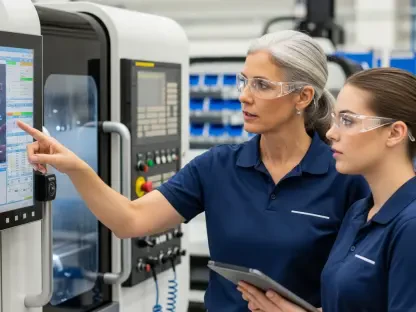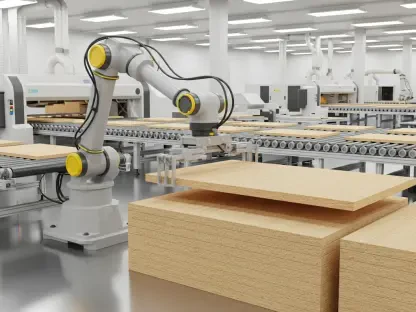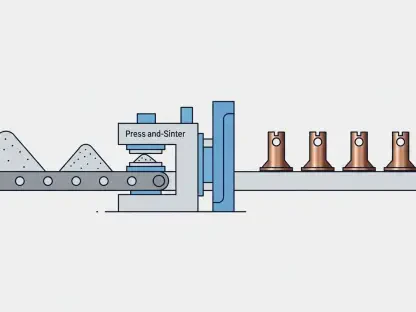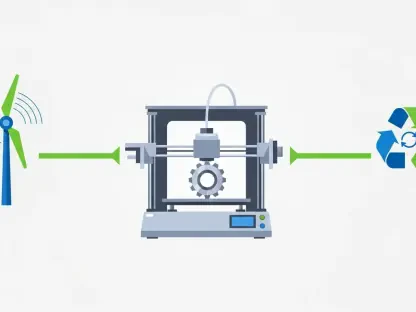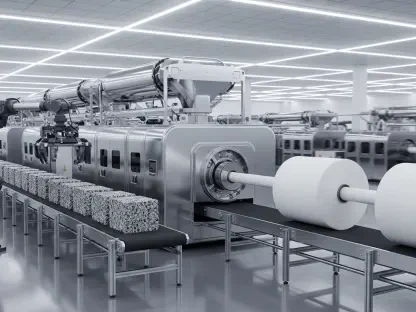The manufacturing sector finds itself at a critical juncture, wrestling with a complex web of challenges that threaten its very foundation—an aging workforce, a stark talent shortage projected to leave 2.1 million roles unfilled by 2030, and mounting pressure to digitize operations amid economic and geopolitical turbulence. These issues are not mere statistics; they represent a ticking clock for an industry central to global supply chains, where productivity and competitiveness are at stake. The urgency to upskill workers has surged to the forefront, but traditional approaches fall short in a landscape defined by rapid technological change. This exploration delves into a transformative solution: technology designed with human needs at its heart. By prioritizing usability and accessibility, such tools can empower the workforce, close the skills gap, and redefine how manufacturers prepare for the future.
The Urgency of Workforce Challenges
Talent Shortages and Aging Workforce
The scale of the talent crisis in manufacturing is staggering, with forecasts indicating that by 2030, over 2 million positions could remain vacant, creating a ripple effect on production capacity and economic stability. This shortage is compounded by an aging workforce, where seasoned employees are retiring faster than new talent can be trained to replace them. The loss of institutional knowledge poses a significant risk, as younger workers often lack the hands-on experience needed for complex roles. Without effective strategies to transfer skills and attract fresh talent, manufacturers face declining output and innovation. The situation demands more than recruitment; it calls for a reimagining of how skills are built and retained in an industry under strain.
Beyond the numbers, the human impact of this workforce gap is profound, as remaining employees bear heavier workloads, leading to burnout and reduced morale. Factories struggle to maintain quality standards when understaffed, and the inability to scale operations limits competitiveness in a global market. Addressing this crisis requires leveraging technology not just to automate tasks, but to empower workers with the tools they need to adapt quickly. Upskilling must become a priority, focusing on accessible methods that enable individuals to step into roles with confidence, regardless of their starting point. Only by tackling these demographic challenges head-on can the sector secure its future.
Digitization Pressures
Manufacturers are under relentless pressure to modernize, driven by external forces such as fluctuating trade policies, supply chain disruptions, and economic uncertainty that demand agility and efficiency. Digitization is no longer optional; it’s a survival mechanism in a world where competitors who embrace advanced systems gain a clear edge. The push to integrate technologies like artificial intelligence (AI) and data analytics into operations is fueled by the need to optimize processes and reduce costs. However, this transition often clashes with workforce readiness, as employees accustomed to analog methods struggle to adapt to digital environments without proper support.
This digital imperative also intersects with geopolitical challenges, where tariffs and regional conflicts disrupt raw material flows, forcing manufacturers to pivot quickly through tech-driven solutions. Yet, the rush to adopt new systems can backfire if workers are left behind, unable to navigate complex tools or understand their purpose. The result is a widening gap between operational goals and human capability, stalling progress. A balanced approach that aligns technological upgrades with employee empowerment is essential to ensure that digitization becomes a catalyst for growth rather than a source of friction in the industry.
The Promise and Pitfalls of Technology
Executive Optimism Around Tech
Industry leaders are strikingly bullish on the role of technology in reshaping workforce development, with the 2025 State of Production Health (SOPH) report revealing that 99% of executives believe advanced tools will have a positive impact on upskilling. This confidence stems from the potential of innovations like AI to streamline training and enhance productivity, offering solutions to long-standing inefficiencies. Even more compelling is the finding that nearly 90% of these leaders see technology as a job creator rather than a threat, countering fears of widespread automation displacing workers. This optimism signals a transformative shift in how the sector views digital tools as allies in building a resilient workforce.
Digging deeper, this positive outlook reflects a recognition that technology can address critical pain points, from reducing downtime to improving safety through predictive analytics. Executives envision a future where workers, equipped with smart systems, can tackle complex tasks with greater precision and less effort. However, translating this vision into reality requires more than investment in cutting-edge solutions; it demands a focus on how these tools are received by those on the factory floor. Bridging the gap between boardroom enthusiasm and frontline execution remains a pivotal challenge for manufacturers aiming to capitalize on this wave of innovation.
Usability as a Barrier
Despite the enthusiasm for technology, poorly designed digital tools often become stumbling blocks, exacerbating the skills gap rather than solving it. Frontline workers, who are the backbone of manufacturing operations, frequently encounter interfaces that are anything but user-friendly, leading to extended onboarding periods and a higher likelihood of errors. When systems are unintuitive, they erode trust in technology, leaving employees skeptical of its value and hesitant to embrace change. This disconnect not only slows down adoption but also undermines the efficiency gains that digital transformation is supposed to deliver.
The World Economic Forum has pointed out a crucial insight: the challenge isn’t solely a lack of skills among workers, but rather the failure of tools to accommodate non-specialist users. When technology feels alien or overly complex, it creates frustration rather than empowerment, stalling progress across entire facilities. Workers spend more time grappling with software than focusing on their core tasks, which diminishes morale and productivity. Addressing this usability barrier is not a luxury but a necessity, as the success of any digital initiative hinges on how seamlessly it integrates into the daily grind of those who use it most.
Human-Centered Design as the Solution
Redefining Tech for Accessibility
Human-centered technology stands out as a powerful antidote to the usability woes plaguing manufacturing, offering intuitive interfaces and contextual support that drastically shorten learning curves. Imagine tools as accessible as everyday devices like smartphones, where functionality feels instinctive, allowing users to focus on outcomes rather than mechanics. In a factory setting, this translates to systems that guide new hires through processes with clear prompts, enabling them to reach proficiency in weeks rather than months. Such design not only accelerates onboarding but also levels the playing field, empowering less experienced workers to perform at the standard of seasoned veterans.
Moreover, accessibility in tech design fosters confidence, a critical yet often overlooked factor in workforce development. When employees interact with tools that provide real-time feedback and adapt to their pace, they feel supported rather than overwhelmed. This approach minimizes errors and boosts engagement, as workers see technology as a partner rather than an obstacle. By prioritizing human needs—such as clear navigation and relevant assistance—manufacturers can transform digital tools into catalysts for skill mastery, ensuring that every employee, regardless of background, can contribute effectively to operational goals.
Moving Beyond Traditional Training
Traditional training methods, such as dense manuals or sporadic classroom sessions, are increasingly obsolete in the face of modern manufacturing’s fast-paced, intricate demands. These outdated approaches often leave workers ill-prepared for the dynamic challenges of the shop floor, where split-second decisions and adaptability are key. Relying on static resources fails to address the nuances of real-world tasks, resulting in knowledge gaps that hinder performance. As the industry evolves, clinging to such methods risks widening the divide between what workers know and what they need to know to thrive.
A more effective path lies in embedding upskilling directly into daily workflows, using technology with built-in learning features like automated suggestions and adaptive tutorials. This shift ensures that skill development isn’t a disconnected event but a continuous process, seamlessly integrated into the job itself. Workers learn by doing, receiving guidance in real time as they navigate tasks, which reinforces retention and builds practical expertise. By redefining training as an ongoing, hands-on journey, manufacturers can equip their teams to handle complexity with agility, aligning human growth with operational excellence.
Trends Shaping the Future of Upskilling
Rapid AI Adoption and Worker Trust
The adoption of AI in manufacturing is accelerating at an unprecedented rate, with the SOPH report noting a tripling of companies deploying it across more than half their facilities in just the past year. This surge reflects a broader push to harness data-driven insights for everything from predictive maintenance to process optimization. However, rolling out AI is only half the battle; its impact depends heavily on whether workers trust and understand these systems. Without buy-in from those on the ground, even the most sophisticated tools risk becoming underutilized, failing to deliver the promised efficiency gains.
Securing that trust starts with involving frontline staff in the design and implementation process, ensuring that AI tools address real operational needs rather than theoretical ideals. When workers see technology as relevant and supportive, resistance fades, paving the way for smoother adoption. Transparency about how AI functions and its benefits also plays a vital role in dispelling fears of job displacement. Manufacturers must prioritize partnerships with vendors who deliver reliable systems, measured by metrics like alert accuracy, to build a foundation of confidence that sustains long-term digital transformation.
Generational Perspectives and Continuous Learning
Generational differences add another layer to the upskilling challenge, as Millennials and Gen Z often view technology more favorably than older cohorts but also report higher stress levels in factory environments. These younger workers, while digitally savvy, grapple with the intense demands of modern manufacturing, where precision and speed leave little room for error. Their openness to AI and digital tools offers an opportunity, yet it comes with the need for solutions that alleviate workplace tension rather than amplify it. Tailoring tech to provide clarity and autonomy can make a significant difference in their experience.
Parallel to this, the industry is witnessing a paradigm shift from viewing upskilling as a one-time event to embracing it as a continuous, integrated process. Leading manufacturers are embedding learning into workflows through flexible, familiar systems that support employees from their first day. This approach acknowledges that digital transformation isn’t merely a technical upgrade but a human-centered opportunity to foster growth. By aligning tools with the evolving needs of diverse generations, the sector can cultivate a culture of ongoing development, ensuring resilience in the face of change.
Empowering Tomorrow’s Workforce
Reflecting on the journey through manufacturing’s challenges, it’s evident that human-centered technology emerges as a linchpin for upskilling in an era of unprecedented transformation. The industry wrestles with talent shortages and digitization demands, finding that traditional methods fall short against the pace of change. Solutions rooted in intuitive design and continuous learning prove instrumental, as they bridge skill gaps and rebuild trust in digital tools. Looking ahead, the path forward lies in sustained investment in accessible systems, deeper collaboration with frontline workers for tech development, and a commitment to embedding education into every task. Manufacturers who act on these insights stand to not only enhance productivity but also nurture a workforce equipped for tomorrow’s uncertainties, turning challenges into enduring strengths.


